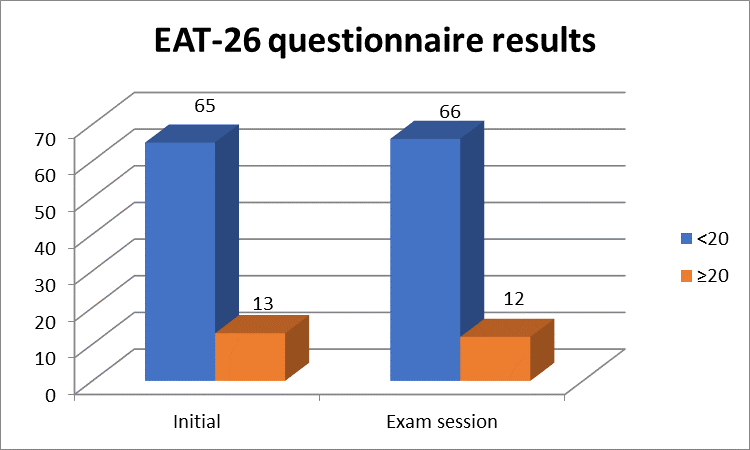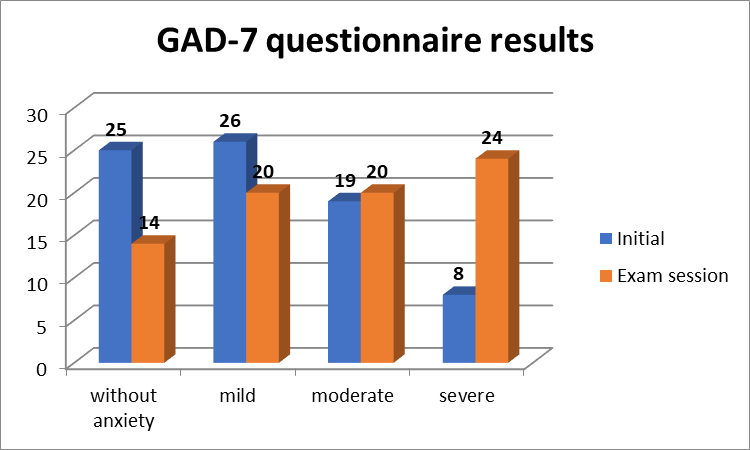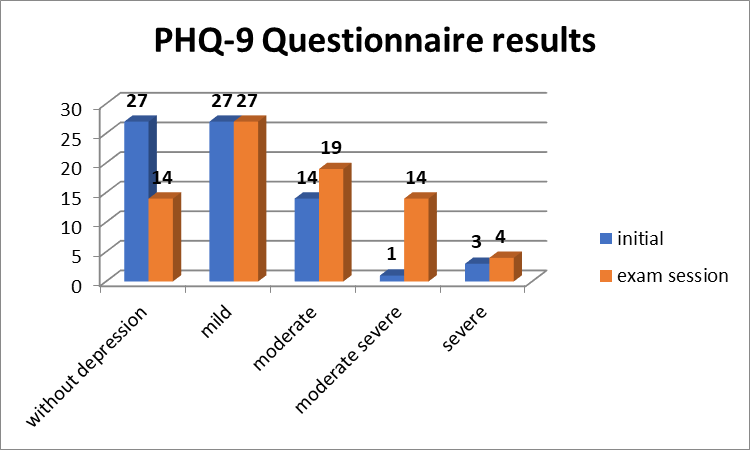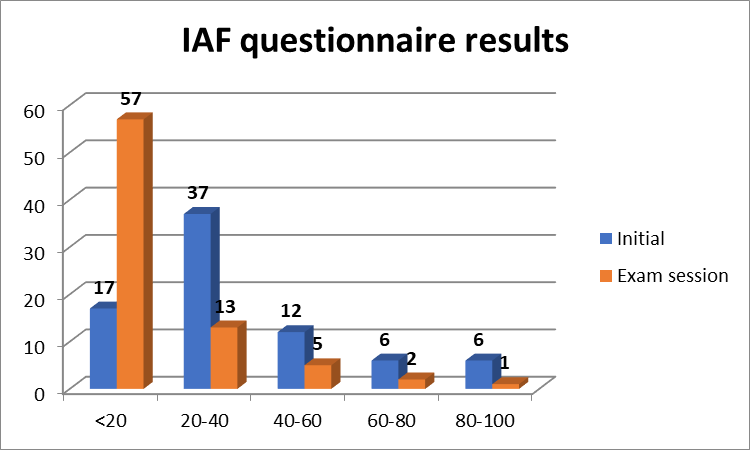Abstract
Medical students have an increased risk of developing psychological and eating disorders due to the academic stress and the degree of physical activity. The stress during the exam session affects eating attitudes, mental health and physical activity. The aim of the study was to analyse the eating behaviors, mental status and grades of physical activity before and during exam session in medical college students. We performed an analytical observational study in a population of 78 undergraduate 1st and 2nd year medical students (66 girls and 12 boys). Eating-related attitudes were studied using the EAT- 26 questionnaire. Anxiety and depression scores were evaluated with GAD7 and PHQ-9 questionnaires. Physical activity was also assessed. All of the questionnaires were given before and during the exam session. The scores of EAT 26 questionnaire reflect a normal reporting of dieting attitudes, regardless of the time of evaluation. Regarding assessment of anxiety (GAD7) and depression (PHQ-9), an increase in the number of cases of severe anxiety and depression during the exams session was shown. In addition, the physical activity index dropped significantly during the exam period. The academic and psychological stress during the exam session affected the mental status of the medical students causing an increase in the anxiety and depressions scores. Also, the physical activity diminished, emphasizing their psychological state. No significant changes in eating behavior were observed.
Keywords: Eating attitudeshealthphysical activitystudents
Introduction
The problems of organizing and using time are one of the current preoccupations of modern society. For young people in the student healthcare environment, the structure of their time is focused mainly on static activities, carried out in classrooms and in seminar rooms, in reading rooms, laboratories, libraries, dissection rooms, and so on. Knowing how to use their free time and how to use the forms of physical activities for recreation and leisure constitutes a matter of topical interest which should be of interest in equal measure for academic institutions as well as for students (Petreanu, 2014).
Dragulin and Pelin (2006) consider the intellectual work that students go through during college years, along with the physical work, an essential condition for multilateral development. The success of their studies depends on a number of skills which should be acquired gradually including planned, rhythmic activities, the power of concentration, and the interest for the discipline studied.
Students in the healthcare academic environment undergo increased academic stress. Among the factors that may cause and increase this stress are: the large amount of information which they must assimilate within a specified period of time, the high number of exams and colloquia and the academic competitiveness emphasized by the classification required by university rules. Factors relating to lifestyle, as well as the unsatisfactory accommodation conditions in the university campuses, the irregular and fast-food-based diet, excessive consumption of caffeine and sometimes of alcohol, nightly entertainment /sleepless nights are additional sources of stress. In addition to all these, the separation from the family environment, adapting to responsibility as adults, change in the cultural environment, and the pressure and expectations of the family on the student may increase the degree of psychological distress of the latter, creating multiple-level disorders.
Problem Statement
The psychic fatigue characteristic during the exam period can be due to a mismanagement of the time allotted in the educational process. Thus, students try to assimilate a large amount of information during the exam session, using psychotropic substances, such as caffeine and energizing juices. The quality and duration of sleep are also affected, all of which contribute to the increase in distress, mental fatigue and nervous tension.
All these are likely to have repercussions on food intake behavior and mental health, and in the long term, may also influence the degree of academic performance and the level of professional development, increasing the rates of university dropout. In addition, students may develop psychological disorders of eating behavior (anorexia, bulimia) or anxiety, depression or even suicidal ideation.
Certain researches that studied anxiety and depression of Romanian students have indicated an incidence rate of anxiety higher than 43.2% and, in addition, an increased incidence rate of depression of 42.1% (Pintea, 2015). According to the study conducted by Dahlin, Joneborg and Runeson, (2005), medical students had higher depression rates than the general population of students and female students had higher rates than male students.
Research Questions
Does the stress during the exam session affect eating attitudes, mental health and physical activity index?
Purpose of the Study
The aim of the study was to analyse the eating behaviors, mental status and grades of physical activity before and during exam session in medical college students. At the same time, we aimed to draw conclusions about the impact of stress during exam session on medical college students.
Research Methods
The study was carried out by applying the following methods: study of the specialized scientific literature, and the test method - by applying 4 questionnaires and statistical-mathematical methods. So, attitudes relating to food were studied using the questionnaire "The Eating Attitudes Test, EAT -26": self-evaluation method of symptoms and concerns characteristic to eating disorders. This test contains 26 items that address symptoms specific to eating behavior, in particular relating to bulimia and anorexia (Mocanu, 2013).
The level of anxiety was assessed by the Generalised Anxiety Disorder Assessment (GAD 7) which is a well-known questionnaire used for the screening and for evaluation of generalized anxiety disorder (Spitzer, Kroenke, Williams, & Löwe, 2006). It comprises seven items regarding the frequency of anxiety symptoms within the past two weeks (of responding to the questionnaire): having difficulties in relaxing; worrying too much about normal life situations; feeling agitated; on edge and scared about future events; and being easily irritable (Swinson, 2006). After (Ruiz at al, 2011), the questionnaire provides four variants of responses depending on the frequency of the symptoms: no problem at all (0 points), several days of having symptoms (1 point), more than half the days in the last two weeks (2 points) and symptoms nearly every day (3 points). Furthermore, the results are divided into classes of anxiety severity according to the scores: below 5 points refers to no anxiety symptoms, 5 to 9 points indicates mild anxiety, 10 to 14 shows moderate anxiety and a score of 15 to 21 points corresponds to severe anxiety. The Patient Health Questionnaire (PHQ – 9) is a frequently used test comprising nine items assessing the presence and severity of depressive symptoms within the last two weeks (Kroenke, Spitzer, & Williams, 2001).
The PHQ-9 test items are derived from the diagnostic symptoms of depression from the Diagnostic and Statistical Manual of Mental Disorders, 4th Edition (DSM-IV). The items evaluate the degree of pleasure in participating in daily affairs, the frequency of depressive symptoms, sleeping disorder, capacity to concentrate, degree of self-esteem, eating behavior, problems, capacity of enjoying life and also assesses the risk of suicide. Responses scale ranges from “0” (Not at all) to “3” (nearly every day). The results are based on the total score as follows: a score under 5 points equals no depression symptoms; a 5 to 9 points total score indicates a mild depression; 10 to 14 a moderate depression; 15 to 19 points refers to moderately severe disorder; a score above 20 points means severe depression. (Inoue at al 2012, Stafford at al., 2007). With regard to the physical condition level, the Physical Activity Index (IAF) was used in order to determine this (Dumitru, 1997).
78 students (66 females and 12 males), from the first and second years of study at the Faculty of Medicine and Pharmacy of the "Carol Davila" University of Medicine and Pharmacy in Bucharest participated in this study on a voluntary basis. Subjects responded voluntarily on all the tests set out in the same order for all, and were told to answer all questions as accurately, honestly and completely as possible. In order to choose the appropriate time to apply the 4 questionnaires, the structure of the time allotment of the activities of a medical student from the first and second years of study was analysed. This time allotment was found to be divided into the following periods during an academic year: time periods (semesters) in which instructive-educational processes were scheduled, such as courses, seminars, laboratories, practical lessons, and periods during which assessments/exam sessions and holidays are scheduled. As such, 2 tests were carried out; one during the courses and the other during an exam session in the academic year 2016/2017. All students also expressed their agreement in writing to be a part of this study.
Findings
Figure
The assessment during the exam session did not indicate significant changes (figure

The questionnaire GAD-7 indicated the following results at the initial assessment (figure

The degree of depression was evaluated using the PHQ-9 questionnaire. The initial results during courses was: without depression 38%, mild depression 38%, moderate 19%, moderate severe 1% and severe depression 4%. During the exam session, the results indicated: without depression 18%, mild depression 35%, moderate 24%, moderate severe 18%, and severe depression 5%. Thus, the number of students with a score corresponding to the state of moderately severe depression increased significantly from 1% to 18% (p<0.005) (figure

The quality and effects on the body of physical exercises was estimated using the IAF Physical Activity Index. This is assessed on the basis of 3 parameters: intensity (I) 5 items, duration (D) 4 items and frequency (F) 5 items and calculated by multiplying the scores of each parameter: IAF = I x D x F, on the basis of which depending on the score obtained is determined the category of physical condition (Boros-Balint, Tache, 2007).
The analysis of the level of physical activity using the IAF questionnaire showed the following initial results (figure

During the exam session, as expected, the level of physical activities decreased, with the results as follows: 73% of the students reported a sedentary lifestyle and 17% a relatively sedentary lifestyle. Only 6 % reported a reasonable physical condition with 3%, an active lifestyle and 1% a very active lifestyle. Therefore, the statistically significant increase in the number of sedentary students from 22% to 73% is noticeable (p<0.005) (figure
The scores of EAT 26 questionnaire reflect a normal reporting of diet attitudes, regardless of the time of evaluation. Regarding assessment of anxiety (GAD-7) and depression (PHQ-9) questionnaires an increase in the number of cases of severe anxiety and depression was noticed during the exam session. In addition, the physical activity index dropped significantly during the exam period.
In our study, increase in anxiety and depression grades amongst medical students were noted, similar to literature data (Musiat at al., 2014, Dyrbye, Thomas, Shanafelt, 2006, Ibrahim, Kelly, Adams, Glazebrook, 2013). However, the literature data on the prevalence of anorexia and bulimia among students is contradictory. On the one hand, high prevalence was reported in some studies (Babar at al., 2002, Rizvi et al., 2010, Zakhem at al., 2015) and, on the other hand, there were researchers indicating a low prevalence such as in the study by Beekley at al. (2009).
Conclusion
In general, students from the medical academic environment are faced with delicate situations from the very first year at the university, where there is an anxiety relating to their adaptation to their new environment. Their whole conduct is marked by several aspects on multiple levels; physiological, psychological and social. Adaptation of the student's body to different demands, such as university type learning (study) varies depending on many factors, among which, an important role is also the bio-social heritage.
In conclusion, this study shows that the academic and psychological stress during the exam session does affect the mental status of the medical students causing an increase in the anxiety and depressions scores. At the same time, no statistically significant changes in the eating behavior recorded by the EAT 26 questionnaire, before and during exam session, were observed. Also, the physical activity diminishes, emphasizing their psychological state.
It can be noticed that the level of physical condition dropped significantly from the course period to the exam period. At the initial evaluation during courses, during which weekly physical education and sports lessons program were mandatory, the results for physical activity were good. However, during the exam period, the results showed that most students did not participate in enough physical activities in order to be in optimal physical condition.
Hence, the importance of a constant physical effort to maintain a proper physical and mental health cannot be underestimated. The decrease in the degree and frequency of physical activity may favor weight gain, eating disorders and, last but not least, significant psychological consequences. This can have a negative effect on the academic performance of the medical students, causing higher dropout rates, which would be a great loss to the population as qualified physicians are crucial in sustaining the population’s good health. The results of this study highlight that the stress during the exam session affect mental health and physical activity index of medical college students, causing an increase in the anxiety and depressions scores recorded with the PHQ-9 and GAD-7 questionnaires . Furthermore the stress during exam session diminishes the degree of physical activity assessed with the IAF questionnaire. Thus, academic institutions should be serious in undertaking efforts to ensure that this group of students maintain their mental and physical health, by promoting healthy eating policies and regular sports during stressful periods in the university. Further studies are necessary to investigate the long-term consequences on the population of future physicians of the increased incidence of anxiety and depression disorders and of a low physical activity.
References
- Babar, N., Alam, M., Ali, S. S., Ansari, A., Atiq, M., Awais, A., Israr, S. M. (2002). Anorexic behaviour and attitudes among female medical and nursing students at a private university hospital. Journal of the Pakistan Medical Association, 52, 272–276. Retrieved from http://www.jpma.org.pk/full_article_text.php?article_id=2272
- Beekley, M. D., Byrne, R., Yavorek, T., Kidd, K., Wolff, J., & Johnson, M. (2009). Incidence, prevalence, and risk of eating disorder behaviors in military academy cadets. Military Medicine, 174, 637–641. Retrieved from http://militarymedicine.amsus.org/doi/pdf/
- Boros – Balint, I., Tache, S. (2007). Psycho – Physiological particularities of the individual, stress and physical effort. Palestrica Milennium III – Civilizations and sport, vol.VIII, nr.2 (28), iunie 2007, 93-97. Retrieved from http://pm3.ro/pdf/28/28%20INTEGRAL.pdf#page=23
- Dahlin, M., Joneborg, N. & Runeson, B. (2005), Stress and depression among medical students: a cross –sectional study. Medical Education, 39, 594–604; doi:
- Dragulin, I., Pelin, R. (2006). Gymnastics guide for students. Bucharest, Printech Press, p.132-134
- Dumitru, G. (1997). Health through sport on everyone’s behalf. Bucharest, The Romanian Federation The Sport for All, p.59
- Dyrbye, L.N., Thomas, M.R., Shanafelt, T.D. (2006). Systematic review of depression, anxiety, and other indicators of psychological distress among U.S. and Canadian medical students. Academic Medicine: journal of the Association of American Medical Colleges, 81(4), 354-73
- Ibrahim, A.K., Kelly, S.J., Adams, C.E., Glazebrook C.J. (2013). A systematic review of studies of depression prevalence in university students, Journal of psychiatric research, 47(3):391-400. doi:
- Inoue, T., Tanaka, T., Nakagawa, S., ...Koyama, T. (2012). Utility and Limitations of PHQ-9 in a Clinic Specializing in Psychiatric Care. BMC Psychiatry. 12: 1–6. DOI:
- Kroenke, K., Spitzer, R.L., Williams, J.B. (2001). The PHQ-9: validity of a brief depression severity measure. Journal of general internal medicine, 16(9), 606–613. Retrieved from https://www.ncbi.nlm.nih.gov/pubmed/11556941
- Mocanu, V. (2013). Overweight, obesity and dieting attitudes among college students in Roumania. Acta Endocrinologica, IX, no. 2, p. 241-248, doi:
- Musiat, P., Conrod, P., Treasure, J., Tylee, A., Williams, C., & Schmidt, U. (2014). Targeted Prevention of Common Mental Health Disorders in University Students: Randomised Controlled Trial of a Transdiagnostic Trait-Focused Web-Based Intervention, Plose One, April 2014, 9(4), e93621. Retrieved from
- Petreanu, M. (2014). Aerobics gymnastics – a determining mean (factor) in improving the quality of life of young people in medical academic environment. Bucharest, Bren Press, p.73
- Pintea, A. (2015). Anxiety and depression in students. School and University Medicine Journal, II(3),iulie2015,14-19 Retrieved from http://www.medicinascolara.ro/download/revista/vol2_nr3_2015/rmsu_vol2_nr3_2015.pdf#page=16
- Rizvi, A.H., Awaiz, M., Ghanghro, Z., Jafferi, M.A., Aziz, S. (2010). Pre-examination stress in second year medical students in a government college, Jornal of Ayub Medical College Abbottabad. 2010 Apr-Jun22(2),152-5, PMID:21702291. Retrieved from https://www.ncbi.nlm.nih.gov/pubmed/21702291
- Ruiz, M.A., Zamorano, E., Garcia-Campayo, J., Pardo, A., Freire, O. & Rejas, J. (2011). Validity of the GAD-7 scale as an outcome measure of disability in patients with generalized anxiety disorders in primary care. Journal of affective disorders, 128(3),277-86. doi:
- Spitzer, R. L., Kroenke, K., Williams, J. B.W. & Löwe, B. (2006). A brief measure for assessing generalized anxiety disorder: The GAD-7". Archives of Internal Medicine 166(10),1092–7. doi:10.1001/archinte.166.10.1092 PMID 16717171
- Stafford, L., Berk, M., Jackson, H.J. (2007). Validity of the Hospital Anxiety and Depression Scale and Patient Health Questionnaire-9 to screen for depression on patients with coronary artery disease, General Hospital Psychiatry, 29(5),417-424. DOI:
- Swinson, R.P. (2006). The GAD-7 scale was accurate for diagnosing generalized anxiety disorder. Evidence-Based Medicine. 11 (6):184. Doi:10.1136/ebm.11.6.184. PMID 17213178
- Zakhem, E., El Hage, R., Pezé, T., Hurdiel, R., Zunquin, G., Theunynck, D., (2015). Factors associated with eating disorders in students of the University of Littoral Côte d'Opale, Revue d’epidemiologie et de sante publique. 2015 Aug; 63(4),259-65. doi: 10.1016/j.respe.2015.04.014, PMID:26143089
Copyright information

This work is licensed under a Creative Commons Attribution-NonCommercial-NoDerivatives 4.0 International License.
About this article
Publication Date
14 September 2017
Article Doi
eBook ISBN
978-1-80296-029-7
Publisher
Future Academy
Volume
30
Print ISBN (optional)
-
Edition Number
1st Edition
Pages
1-376
Subjects
Health, public health, preventive healthcare, preventive care, preventive medicine
Cite this article as:
Petreanu, M., Mirica, A., Mirica, R., & Petreanu, A. G. (2017). Eating Behavior, Mental Health And Degree Of Physical Activity In Medical Students. In Z. Bekirogullari, M. Y. Minas, & R. X. Thambusamy (Eds.), Health and Health Psychology - icH&Hpsy 2017, vol 30. European Proceedings of Social and Behavioural Sciences (pp. 228-235). Future Academy. https://doi.org/10.15405/epsbs.2017.09.21

